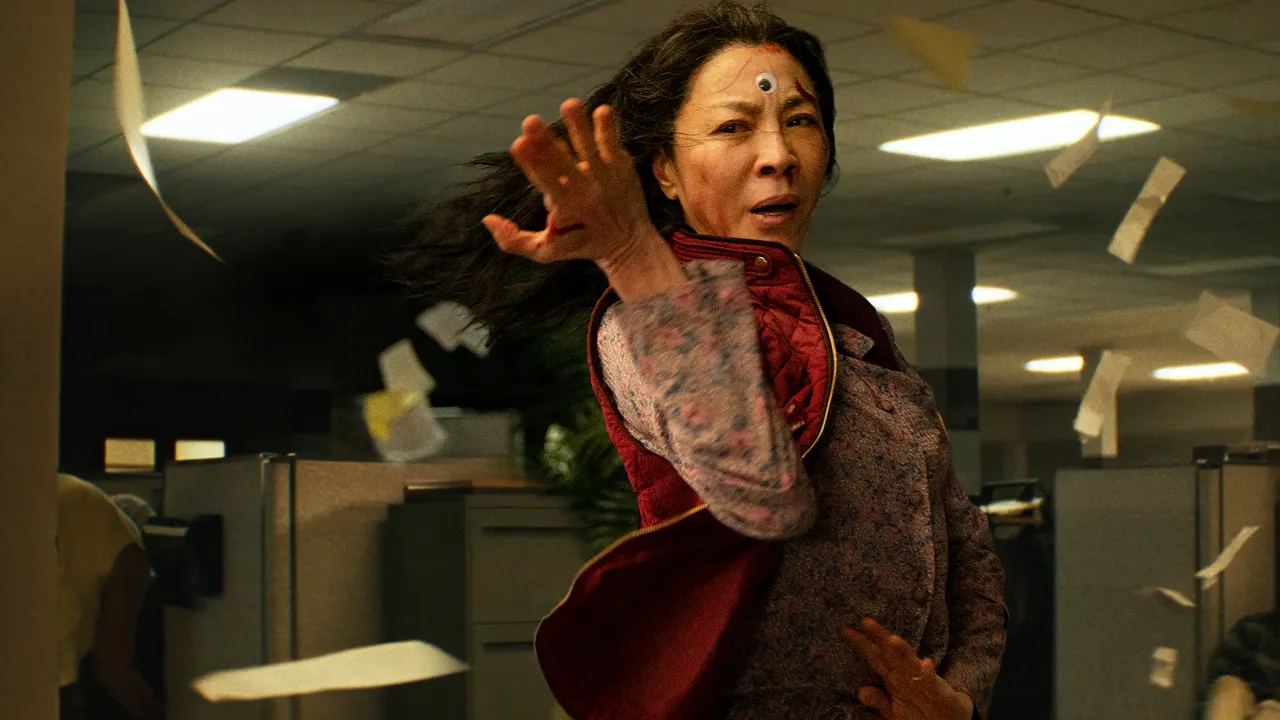
c/o A24
This article contains spoilers for “Everything Everywhere All at Once.”
Sentient rocks with googly eyes. A society where people have hot dogs for fingers. A fanny pack used as a deadly weapon. “Everything Everywhere All at Once,” the new film from directors Daniel Kwan and Daniel Scheinert, known collectively as Daniels, is a multifaceted, multiversal tale that is simultaneously movingly intimate and eclectic enough to defy description.
When we meet protagonist Evelyn Wang (Michelle Yeoh), she’s struggling to keep it together: The laundromat she runs in an anonymous California strip mall is under financial strain; her husband Waymond (Ke Huy Quan) wants a divorce; and she’s still coming to terms with the fact that her daughter, Joy (Stephanie Hsu), is dating a woman. What’s more, her irritable father (James Hong) has recently arrived from China to stay with her and she has to keep things stable long enough to survive an audit from the Internal Revenue Service (IRS).
But on the elevator up to the office of IRS inspector Deirdre Beaubeirdra (Jamie Lee Curtis), things take a turn for the unusual. In the blink of an eye, Waymond’s personality transforms from his typical meek self into a dashing, confident secret agent type. He explains to a stunned Evelyn that she exists in one of the infinite multiverses. Every decision that anyone makes leads to a new branch timeline: some nearly identical to ours, others entirely different. The man explaining this to her now is the Waymond from the Alpha universe, where technology was developed to allow people to tap into their parallel selves through a technique known as verse-jumping.
Evelyn, who would rather focus on keeping her family in order than going on a sci-fi adventure, wants to brush off the news. But Alpha Waymond gravely explains that the multiverse is in grave danger of destruction by a powerful being known as Jobu Tupaki, and he believes that this universe’s Evelyn may be the only one capable of stopping this threat.
As it turns out, Jobu Tupaki is the Alpha universe’s incarnation of Joy. The Evelyn in the Alpha universe subjected Joy to extensive verse-jumping, fracturing her psyche, forcing her to experience all multiverses at once, and eventually setting her on a path of existential vengeance as Jobu Tupaki.
After these revelations, the IRS building becomes a site of life-or-death combat as Evelyn and Waymond fend off Jobu Tupaki’s multiversal minions. The action sequences, drawing from kung fu cinema, are among the most creative and exciting found in films produced on this side of the Pacific. As the verse-jumping escalates, and Evelyn catches glimpses of her other potential lives, Kwan and Scheinert infuse the presentation with a sugar rush of hyperkinetic style. (Think love child of Edgar Wright and effects-infused TikTok edits).
Prior to their film career Kwan and Scheinert gained recognition for their work on the madcap 2013 video for DJ Snake and Lil Jon’s “Turn Down for What,” and that same energy is evident in “Everything Everywhere All at Once.” At the same time, the film feels packed with references to everything from the action sequences of “The Matrix” to the visually sumptuous melancholy of Wong Kar-Wai. The nonstop energy of the film’s style prevents it from ever getting boring, although it borders on grating at certain moments.
Despite its unabashed maximalism and absurdity, at the heart of “Everything Everywhere All at Once” is something deeply intimate and human. As Evelyn becomes able to quite literally see the lives she might have lived if she had made different choices, she becomes consumed with a relatable sense of “what if” anxiety. What if she had never left China, never married Waymond? In at least one multiverse, she’d be a glamorous movie star. Our Evelyn, by comparison, feels like a complete failure, and indeed, Alpha Waymond’s assertion that she has the most unrealized potential of any of her selves elevates this inadequacy to a cosmic scale.
The film also serves as a poignant reminder of the multifaceted nature of self, and the risks of stretching oneself too thin. Evelyn feels this strain, but as she realizes, so does Joy, who feels increasingly alienated by her mother’s refusal to embrace her sexuality. Healing these rifts and bringing the two to a greater understanding of themselves and one another is essential not only to the well-being of the Wang family but the survival of the entire multiverse.
Kwan and Scheinert also depict the central characters with warm attention to the nuances of Chinese immigrant experiences. Evelyn is fluidly multilingual, speaking in English to her daughter, Mandarin to her husband, and Cantonese to her father, often blending the three in a single sentence. Central to the story’s themes is the conflict in perspective between an immigrant parent who gave up their world to settle in America, and an American-born child, whose coming of age may lead them away from the family.
Ultimately, it is this depiction of often personal, internal struggles on a zany, kaleidoscopic scale that makes “Everything Everywhere All at Once” such a triumph. It makes our feelings as big as they feel to us and resolves them in a way that’s deeply moving, romantic, and life-affirming. Few of us have had to fend off hordes of interdimensional martial artists while armed only with a fanny pack. But we can all understand the torment of ruminating on hypotheticals and wishing you’d been someone else.
Oscar Kim Bauman can be reached at obauman@wesleyan.edu.
Comments are closed